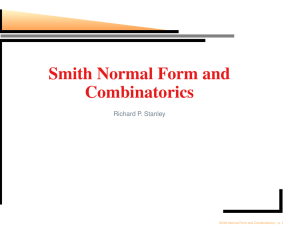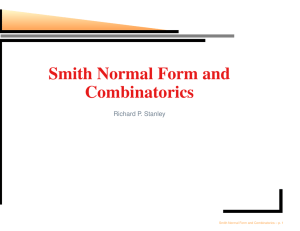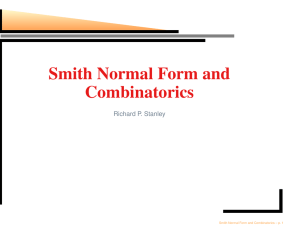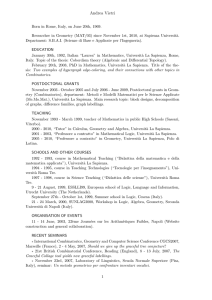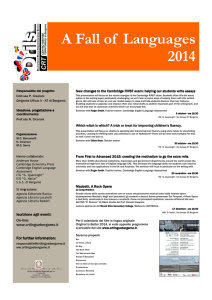Smith Normal Form and Combinatorics Richard P. Stanley
advertisement
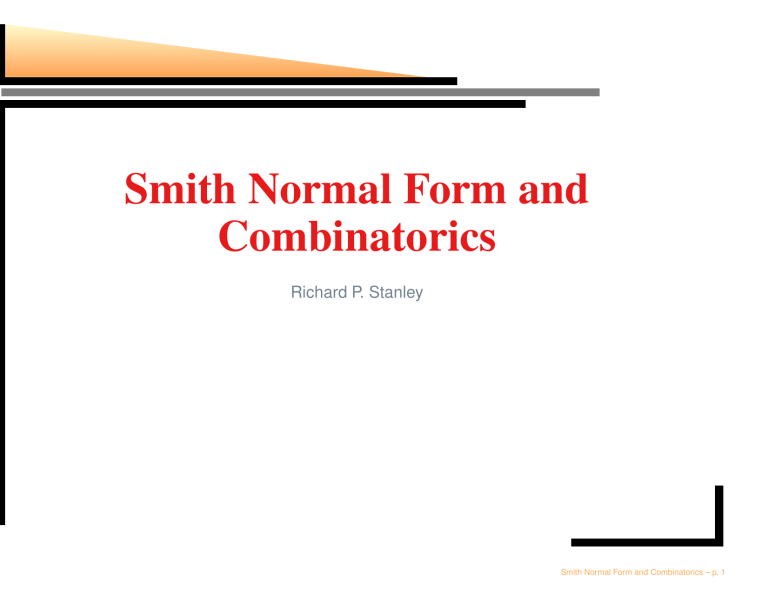
Smith Normal Form and
Combinatorics
Richard P. Stanley
Smith Normal Form and Combinatorics – p. 1
I
Really
Appreciate
Great
E numerative
S uccesses
S tated
E xceptionally
L ucidly
Smith Normal Form and Combinatorics – p. 2
A curious connection
Little known fact: perhaps the most influential
work of Ira is related to
Smith Normal Form and Combinatorics – p. 3
A curious connection
Little known fact: perhaps the most influential
work of Ira is related to
QUAINT CUNEIFORM MYSTICS
Smith Normal Form and Combinatorics – p. 3
A curious connection
Little known fact: perhaps the most influential
work of Ira is related to
QUAINT CUNEIFORM MYSTICS
1
2
3 5 17 11
14 16
22
10 13 15 21
12
8
9
7
6
19 20 18
4
Smith Normal Form and Combinatorics – p. 3
A curious connection
Little known fact: perhaps the most influential
work of Ira is related to
QUAINT CUNEIFORM MYSTICS
1
2
3 5 17 11
14 16
22
10 13 15 21
12
8
9
7
6
19 20 18
4
QUASISYMMETRIC FUNCTION
Smith Normal Form and Combinatorics – p. 3
Smith normal form
A: n × n matrix over commutative ring R (with 1)
Suppose there exist P , Q ∈ GL(n, R) such that
P AQ := B = diag(d1 , d1 d2 , . . . d1 d2 · · · dn ),
where di ∈ R. We then call B a Smith normal
form (SNF) of A.
Smith Normal Form and Combinatorics – p. 4
Smith normal form
A: n × n matrix over commutative ring R (with 1)
Suppose there exist P , Q ∈ GL(n, R) such that
P AQ := B = diag(d1 , d1 d2 , . . . d1 d2 · · · dn ),
where di ∈ R. We then call B a Smith normal
form (SNF) of A.
N OTE . (1) Can extend to m × n.
(2) unit · det(A) = det(B) = dn1 dn−1
· · · dn .
2
Thus SNF is a refinement of det.
Smith Normal Form and Combinatorics – p. 4
Existence of SNF
If R is a principal ideal ring (PIR), such as Z or
K[x] (K = field), then A has a unique SNF up to
units.
Smith Normal Form and Combinatorics – p. 5
Existence of SNF
If R is a principal ideal ring (PIR), such as Z or
K[x] (K = field), then A has a unique SNF up to
units.
Otherwise A “typically” does not have a SNF but
may have one in special cases.
Smith Normal Form and Combinatorics – p. 5
Row and column operations
Over a principal ideal ring, can put a matrix into
SNF by the following operations.
Add a multiple of a row to another row.
Add a multiple of a column to another column.
Multiply a row or column by a unit in R.
Smith Normal Form and Combinatorics – p. 6
Row and column operations
Over a principal ideal ring, can put a matrix into
SNF by the following operations.
Add a multiple of a row to another row.
Add a multiple of a column to another column.
Multiply a row or column by a unit in R.
Over a field, SNF is row reduced echelon form
(with all unit entries equal to 1).
Smith Normal Form and Combinatorics – p. 6
Algebraic interpretation of SNF
R: a PIR
A: an n × n matrix over R with rows
v1 , . . . , vn ∈ Rn
diag(e1 , e2 , . . . , en ): SNF of A
Smith Normal Form and Combinatorics – p. 7
Algebraic interpretation of SNF
R: a PIR
A: an n × n matrix over R with rows
v1 , . . . , vn ∈ Rn
diag(e1 , e2 , . . . , en ): SNF of A
Theorem.
Rn /(v1 , . . . , vn ) ∼
= (R/e1 R) ⊕ · · · ⊕ (R/en R).
Smith Normal Form and Combinatorics – p. 7
Algebraic interpretation of SNF
R: a PIR
A: an n × n matrix over R with rows
v1 , . . . , vn ∈ Rn
diag(e1 , e2 , . . . , en ): SNF of A
Theorem.
Rn /(v1 , . . . , vn ) ∼
= (R/e1 R) ⊕ · · · ⊕ (R/en R).
Rn /(v1 , . . . , vn ): (Kastelyn) cokernel of A
Smith Normal Form and Combinatorics – p. 7
An explicit formula for SNF
R: a PIR
A: an n × n matrix over R with det(A) 6= 0
diag(e1 , e2 , . . . , en ): SNF of A
Smith Normal Form and Combinatorics – p. 8
An explicit formula for SNF
R: a PIR
A: an n × n matrix over R with det(A) 6= 0
diag(e1 , e2 , . . . , en ): SNF of A
Theorem. e1 e2 · · · ei is the gcd of all i × i minors
of A.
minor: determinant of a square submatrix.
Special case: e1 is the gcd of all entries of A.
Smith Normal Form and Combinatorics – p. 8
An example
Reduced Laplacian matrix of K4 :
3 −1 −1
A = −1 3 −1
−1 −1 3
Smith Normal Form and Combinatorics – p. 9
An example
Reduced Laplacian matrix of K4 :
3 −1 −1
A = −1 3 −1
−1 −1 3
Matrix-tree theorem =⇒ det(A) = 16, the
number of spanning trees of K4 .
Smith Normal Form and Combinatorics – p. 9
An example
Reduced Laplacian matrix of K4 :
3 −1 −1
A = −1 3 −1
−1 −1 3
Matrix-tree theorem =⇒ det(A) = 16, the
number of spanning trees of K4 .
What about SNF?
Smith Normal Form and Combinatorics – p. 9
An example (continued)
3 −1 −1 0 0 −1 0
−1 3 −1 → −4 4 −1 → −4
−1 −1 3
8 −4 3
8
0 0 −1
0 0 −1
→0 4 0→0 4 0→
4 −4 0
4 0 0
0 −1
4 0
−4 0
1 0 0
0 4 0
0 0 4
Smith Normal Form and Combinatorics – p. 10
Laplacian matrices
L0 (G): reduced Laplacian matrix of the graph G
Matrix-tree theorem. det L0 (G) = κ(G), the
number of spanning trees of G.
Smith Normal Form and Combinatorics – p. 11
Laplacian matrices
L0 (G): reduced Laplacian matrix of the graph G
Matrix-tree theorem. det L0 (G) = κ(G), the
number of spanning trees of G.
SNF
Theorem. L0 (Kn ) −→ diag(1, n, n, . . . , n), a
refinement of Cayley’s theorem that
κ(Kn ) = nn−2 .
Smith Normal Form and Combinatorics – p. 11
Laplacian matrices
L0 (G): reduced Laplacian matrix of the graph G
Matrix-tree theorem. det L0 (G) = κ(G), the
number of spanning trees of G.
SNF
Theorem. L0 (Kn ) −→ diag(1, n, n, . . . , n), a
refinement of Cayley’s theorem that
κ(Kn ) = nn−2 .
In general, SNF of L0 (G) not understood.
Smith Normal Form and Combinatorics – p. 11
Chip firing
Abelian sandpile: a finite collection σ of
indistinguishable chips distributed among the
vertices V of a (finite) connected graph.
Equivalently,
σ : V → {0, 1, 2, . . . }.
Smith Normal Form and Combinatorics – p. 12
Chip firing
Abelian sandpile: a finite collection σ of
indistinguishable chips distributed among the
vertices V of a (finite) connected graph.
Equivalently,
σ : V → {0, 1, 2, . . . }.
toppling of a vertex v: if σ(v) ≥ deg(v), then
send a chip to each neighboring vertex.
0
5
6
1
2
7
1
2
2
1
3
2
Smith Normal Form and Combinatorics – p. 12
The sandpile group
Choose a vertex to be a sink, and ignore chips
falling into the sink.
stable configuration: no vertex can topple
Theorem (easy). After finitely many topples a
stable configuration will be reached, which is
independent of the order of topples.
Smith Normal Form and Combinatorics – p. 13
The monoid of stable configurations
Define a commutative monoid M on the stable
configurations by vertex-wise addition followed
by stabilization.
ideal of M : subset J ⊆ M satisfying σJ ⊆ J for
all σ ∈ M
Smith Normal Form and Combinatorics – p. 14
The monoid of stable configurations
Define a commutative monoid M on the stable
configurations by vertex-wise addition followed
by stabilization.
ideal of M : subset J ⊆ M satisfying σJ ⊆ J for
all σ ∈ M
Exercise. The (unique) minimal ideal of a finite
commutative monoid is a group.
Smith Normal Form and Combinatorics – p. 14
Sandpile group
sandpile group of G: the minimal ideal K(G) of
the monoid M
Fact. K(G) is independent of the choice of sink
up to isomorphism.
Smith Normal Form and Combinatorics – p. 15
Sandpile group
sandpile group of G: the minimal ideal K(G) of
the monoid M
Fact. K(G) is independent of the choice of sink
up to isomorphism.
Theorem. Let
SNF
L0 (G) −→ diag(e1 , . . . , en−1 ).
Then
K(G) ∼
= Z/e1 Z ⊕ · · · ⊕ Z/en−1 Z.
Smith Normal Form and Combinatorics – p. 15
Second example
Some matrices connected with Young
diagrams
Smith Normal Form and Combinatorics – p. 16
Extended Young diagrams
λ: a partition (λ1 , λ2 , . . . ), identified with its Young
diagram
(3,1)
Smith Normal Form and Combinatorics – p. 17
Extended Young diagrams
λ: a partition (λ1 , λ2 , . . . ), identified with its Young
diagram
(3,1)
λ∗ : λ extended by a border strip along its entire
boundary
Smith Normal Form and Combinatorics – p. 17
Extended Young diagrams
λ: a partition (λ1 , λ2 , . . . ), identified with its Young
diagram
(3,1)
λ∗ : λ extended by a border strip along its entire
boundary
(3,1)* = (4,4,2)
Smith Normal Form and Combinatorics – p. 17
Initialization
Insert 1 into each square of λ∗ /λ.
1
1
1
1
1 1
(3,1)* = (4,4,2)
Smith Normal Form and Combinatorics – p. 18
Mt
Let t ∈ λ. Let Mt be the largest square of λ∗ with
t as the upper left-hand corner.
Smith Normal Form and Combinatorics – p. 19
Mt
Let t ∈ λ. Let Mt be the largest square of λ∗ with
t as the upper left-hand corner.
t
Smith Normal Form and Combinatorics – p. 19
Mt
Let t ∈ λ. Let Mt be the largest square of λ∗ with
t as the upper left-hand corner.
t
Smith Normal Form and Combinatorics – p. 19
Determinantal algorithm
Suppose all squares to the southeast of t have
been filled. Insert into t the number nt so that
det Mt = 1.
Smith Normal Form and Combinatorics – p. 20
Determinantal algorithm
Suppose all squares to the southeast of t have
been filled. Insert into t the number nt so that
det Mt = 1.
1
1
1 1
1 1
Smith Normal Form and Combinatorics – p. 20
Determinantal algorithm
Suppose all squares to the southeast of t have
been filled. Insert into t the number nt so that
det Mt = 1.
1
2 1
1 1
1 1
Smith Normal Form and Combinatorics – p. 20
Determinantal algorithm
Suppose all squares to the southeast of t have
been filled. Insert into t the number nt so that
det Mt = 1.
2 1
2 1 1
1 1 1
Smith Normal Form and Combinatorics – p. 20
Determinantal algorithm
Suppose all squares to the southeast of t have
been filled. Insert into t the number nt so that
det Mt = 1.
2 1
3 2 1 1
1 1 1
Smith Normal Form and Combinatorics – p. 20
Determinantal algorithm
Suppose all squares to the southeast of t have
been filled. Insert into t the number nt so that
det Mt = 1.
5 2 1
3 2 1 1
1 1 1
Smith Normal Form and Combinatorics – p. 20
Determinantal algorithm
Suppose all squares to the southeast of t have
been filled. Insert into t the number nt so that
det Mt = 1.
9 5 2 1
3 2 1 1
1 1 1
Smith Normal Form and Combinatorics – p. 20
Uniqueness
Easy to see: the numbers nt are well-defined and
unique.
Smith Normal Form and Combinatorics – p. 21
Uniqueness
Easy to see: the numbers nt are well-defined and
unique.
Why? Expand det Mt by the first row. The
coefficient of nt is 1 by induction.
Smith Normal Form and Combinatorics – p. 21
λ(t)
If t ∈ λ, let λ(t) consist of all squares of λ to the
southeast of t.
Smith Normal Form and Combinatorics – p. 22
λ(t)
If t ∈ λ, let λ(t) consist of all squares of λ to the
southeast of t.
t
λ = (4,4,3)
Smith Normal Form and Combinatorics – p. 22
λ(t)
If t ∈ λ, let λ(t) consist of all squares of λ to the
southeast of t.
t
λ = (4,4,3)
λ( t ) = (3,2)
Smith Normal Form and Combinatorics – p. 22
uλ
uλ = #{µ : µ ⊆ λ}
Smith Normal Form and Combinatorics – p. 23
uλ
uλ = #{µ : µ ⊆ λ}
Example. u(2,1) = 5:
φ
Smith Normal Form and Combinatorics – p. 23
uλ
uλ = #{µ : µ ⊆ λ}
Example. u(2,1) = 5:
φ
There is a determinantal formula for uλ , due
essentially to MacMahon and later Kreweras
(not needed here).
Smith Normal Form and Combinatorics – p. 23
Carlitz-Scoville-Roselle theorem
Berlekamp (1963) first asked for nt (mod 2)
in connection with a coding theory problem.
Carlitz-Roselle-Scoville (1971):
combinatorial interpretation of nt (over Z).
Smith Normal Form and Combinatorics – p. 24
Carlitz-Scoville-Roselle theorem
Berlekamp (1963) first asked for nt (mod 2)
in connection with a coding theory problem.
Carlitz-Roselle-Scoville (1971):
combinatorial interpretation of nt (over Z).
Theorem. nt = uλ(t)
Smith Normal Form and Combinatorics – p. 24
Carlitz-Scoville-Roselle theorem
Berlekamp (1963) first asked for nt (mod 2)
in connection with a coding theory problem.
Carlitz-Roselle-Scoville (1971):
combinatorial interpretation of nt (over Z).
Theorem. nt = uλ(t)
Proofs. 1. Induction (row and column
operations).
2. Nonintersecting lattice paths.
Smith Normal Form and Combinatorics – p. 24
An example
7 3
2
1
2 1 1
1 1
1
Smith Normal Form and Combinatorics – p. 25
An example
7 3
2
1
2 1 1
1 1
1
φ
Smith Normal Form and Combinatorics – p. 25
Many indeterminates
For each square (i, j) ∈ λ, associate an
indeterminate xij (matrix coordinates).
Smith Normal Form and Combinatorics – p. 26
Many indeterminates
For each square (i, j) ∈ λ, associate an
indeterminate xij (matrix coordinates).
x11
x12
x13
x 21 x 22
Smith Normal Form and Combinatorics – p. 26
A refinement of uλ
uλ (x) =
X Y
xij
µ⊆λ (i,j)∈λ/µ
Smith Normal Form and Combinatorics – p. 27
A refinement of uλ
uλ (x) =
X Y
xij
µ⊆λ (i,j)∈λ/µ
a b c
d e
c
d e
µ
λ
Y
λ/µ
xij = cde
(i,j)∈λ/µ
Smith Normal Form and Combinatorics – p. 27
An example
a
b
d
e
c
abcde+bcde+bce+cde
+ce+de+c+e+1
bce+ce+c
+e+1
c+1
1
de+e+1
e+1
1
1
1
1
1
Smith Normal Form and Combinatorics – p. 28
At
At =
Y
xij
(i,j)∈λ(t)
Smith Normal Form and Combinatorics – p. 29
At
At =
Y
xij
(i,j)∈λ(t)
t
a
b c
d e
f
g h
i
j
n
k l
o
m
Smith Normal Form and Combinatorics – p. 29
At
At =
Y
xij
(i,j)∈λ(t)
t
a
b c
d e
f
g h
i
j
n
k l
o
m
At = bcdeghiklmo
Smith Normal Form and Combinatorics – p. 29
The main theorem
Theorem. Let t = (i, j). Then Mt has SNF
diag(1, . . . , Ai−2,j−2 , Ai−1,j−1 , Aij ).
Smith Normal Form and Combinatorics – p. 30
The main theorem
Theorem. Let t = (i, j). Then Mt has SNF
diag(1, . . . , Ai−2,j−2 , Ai−1,j−1 , Aij ).
Proof. 1. Explicit row and column operations
putting Mt into SNF.
2. (C. Bessenrodt) Induction.
Smith Normal Form and Combinatorics – p. 30
An example
a
b c
d
e
abcde+bcde+bce+cde
+ce+de+c+e+1
bce+ce+c
+e+1
c+1
1
de+e+1
e+1
1
1
1
1
1
Smith Normal Form and Combinatorics – p. 31
An example
a
b c
d
e
abcde+bcde+bce+cde
+ce+de+c+e+1
bce+ce+c
+e+1
c+1
1
de+e+1
e+1
1
1
1
1
1
SNF = diag(1, e, abcde)
Smith Normal Form and Combinatorics – p. 31
A special case
Let λ be the staircase δn = (n − 1, n − 2, . . . , 1).
Set each xij = q.
Smith Normal Form and Combinatorics – p. 32
A special case
Let λ be the staircase δn = (n − 1, n − 2, . . . , 1).
Set each xij = q.
Smith Normal Form and Combinatorics – p. 32
A special case
Let λ be the staircase δn = (n − 1, n − 2, . . . , 1).
Set each xij = q.
uδn−1 (x) xij =q counts Dyck paths of length 2n by
(scaled) area, and is thus the well-known
q-analogue Cn (q) of the Catalan number Cn .
Smith Normal Form and Combinatorics – p. 32
A q -Catalan example
C3 (q) = q 3 + q 2 + 2q + 1
Smith Normal Form and Combinatorics – p. 33
A q -Catalan example
C3 (q) = q 3 + q 2 + 2q + 1
C4 (q) C3 (q) 1 + q
C3 (q) 1 + q
1
1+q
1
1
SNF
∼ diag(1, q, q 6 )
Smith Normal Form and Combinatorics – p. 33
A q -Catalan example
C3 (q) = q 3 + q 2 + 2q + 1
C4 (q) C3 (q) 1 + q
C3 (q) 1 + q
1
1+q
1
1
SNF
∼ diag(1, q, q 6 )
q-Catalan determinant previously known
SNF is new
Smith Normal Form and Combinatorics – p. 33
SNF of random matrices
Huge literature on random matrices, mostly
connected with eigenvalues.
Very little work on SNF of random matrices over
a PIR.
Smith Normal Form and Combinatorics – p. 34
Is the question interesting?
Matk (n): all n × n Z-matrices with entries in
[−k, k] (uniform distribution)
pk (n, d): probability that if M ∈ Matk (n) and
SNF(M ) = (e1 , . . . , en ), then e1 = d.
Smith Normal Form and Combinatorics – p. 35
Is the question interesting?
Matk (n): all n × n Z-matrices with entries in
[−k, k] (uniform distribution)
pk (n, d): probability that if M ∈ Matk (n) and
SNF(M ) = (e1 , . . . , en ), then e1 = d.
Recall: e1 = gcd of 1 × 1 minors (entries) of M
Smith Normal Form and Combinatorics – p. 35
Is the question interesting?
Matk (n): all n × n Z-matrices with entries in
[−k, k] (uniform distribution)
pk (n, d): probability that if M ∈ Matk (n) and
SNF(M ) = (e1 , . . . , en ), then e1 = d.
Recall: e1 = gcd of 1 × 1 minors (entries) of M
n2
Theorem. limk→∞ pk (n, d) = 1/d ζ(n2 )
Smith Normal Form and Combinatorics – p. 35
Work of Yinghui Wang
Smith Normal Form and Combinatorics – p. 36
Work of Yinghui Wang (
)
Smith Normal Form and Combinatorics – p. 37
Work of Yinghui Wang (
)
Sample result. µk (n): probability that the SNF
of a random A ∈ Matk (n) satisfies e1 = 2, e2 = 6.
µ(n) = lim µk (n).
k→∞
Smith Normal Form and Combinatorics – p. 38
Conclusion
2
µ(n) = 2−n 1 −
n(n−1)
X
i=(n−1)2
2−i +
2
nX
−1
i=n(n−1)+1
2−i
3 −(n−1)2
−n 2
(n−1)2
· ·3
)(1 − 3 )
(1 − 3
2
2
n(n−1)
n
−1
Y
X
X
1 −
·
p−i .
p−i +
p>3
i=(n−1)2
i=n(n−1)+1
Smith Normal Form and Combinatorics – p. 39
A note on the proof
uses a 2014 result of C. Feng, R. W. Nóbrega, F.
R. Kschischang, and D. Silva, Communication
over finite-chain-ring matrix channels: number of
m × n matrices over Z/ps Z with specified SNF
Smith Normal Form and Combinatorics – p. 40
A note on the proof
uses a 2014 result of C. Feng, R. W. Nóbrega, F.
R. Kschischang, and D. Silva, Communication
over finite-chain-ring matrix channels: number of
m × n matrices over Z/ps Z with specified SNF
Note. Z/ps Z is not a PID but is a PIR.
Smith Normal Form and Combinatorics – p. 40
Cyclic cokernel
κ(n): probability that an n × n Z-matrix has SNF
diag(e1 , e2 , . . . , en ) with e1 = e2 = · · · = en−1 = 1.
Smith Normal Form and Combinatorics – p. 41
Cyclic cokernel
κ(n): probability that an n × n Z-matrix has SNF
diag(e1 , e2 , . . . , en ) with e1 = e2 = · · · = en−1 = 1.
Y
1
1
1
1 + 2 + 3 + ··· + n
p
p
p
p
Theorem. κ(n) =
ζ(2)ζ(3) · · ·
Smith Normal Form and Combinatorics – p. 41
Cyclic cokernel
κ(n): probability that an n × n Z-matrix has SNF
diag(e1 , e2 , . . . , en ) with e1 = e2 = · · · = en−1 = 1.
Y
1
1
1
1 + 2 + 3 + ··· + n
p
p
p
p
Theorem. κ(n) =
ζ(2)ζ(3) · · ·
Corollary. lim κ(n) =
n→∞
ζ(6)
1
Q
j≥4 ζ(j)
≈ 0.846936 · · · .
Smith Normal Form and Combinatorics – p. 41
Small number of generators
g: number of generators of cokernel (number of
entries of SNF 6= 1) as n → ∞
previous slide: Prob(g = 1) = 0.846936 · · ·
Smith Normal Form and Combinatorics – p. 42
Small number of generators
g: number of generators of cokernel (number of
entries of SNF 6= 1) as n → ∞
previous slide: Prob(g = 1) = 0.846936 · · ·
Prob(g ≤ 2) = 0.99462688 · · ·
Smith Normal Form and Combinatorics – p. 42
Small number of generators
g: number of generators of cokernel (number of
entries of SNF 6= 1) as n → ∞
previous slide: Prob(g = 1) = 0.846936 · · ·
Prob(g ≤ 2) = 0.99462688 · · ·
Prob(g ≤ 3) = 0.99995329 · · ·
Smith Normal Form and Combinatorics – p. 42
Small number of generators
g: number of generators of cokernel (number of
entries of SNF 6= 1) as n → ∞
previous slide: Prob(g = 1) = 0.846936 · · ·
Prob(g ≤ 2) = 0.99462688 · · ·
Prob(g ≤ 3) = 0.99995329 · · ·
Theorem. Prob(g ≤ ℓ) =
−(ℓ+1)2
1 − (3.46275 · · · )2
(1 + O(2−ℓ ))
Smith Normal Form and Combinatorics – p. 42
Jacobi-Trudi specialization
Jacobi-Trudi identity:
sλ = det[hλi −i+j ],
where sλ is a Schur function and hi is a
complete symmetric function.
Smith Normal Form and Combinatorics – p. 43
Jacobi-Trudi specialization
Jacobi-Trudi identity:
sλ = det[hλi −i+j ],
where sλ is a Schur function and hi is a
complete symmetric function.
We consider the specialization
x1 = x2 = · · · = xn = 1, other xi = 0. Then
n+i−1
hi →
.
i
Smith Normal Form and Combinatorics – p. 43
Specialized Schur function
sλ →
Y n + c(u)
u∈λ
h(u)
.
c(u): content of the square u
0 1
2 3
4
−1 0 1 2
−2 −1 0 1
−3 −2
Smith Normal Form and Combinatorics – p. 44
Diagonal hooks D1, . . . , Dm
0
1 2
−1 0 1
−2 −1 0
−3 −2
3 4
2
1
λ = (5,4,4,2)
Smith Normal Form and Combinatorics – p. 45
Diagonal hooks D1, . . . , Dm
0 1 2
−1 0 1
−2 −1 0
3 4
2
1
−3 −2
D1
Smith Normal Form and Combinatorics – p. 45
Diagonal hooks D1, . . . , Dm
0
1 2
−1 0 1
−2 −1 0
−3 −2
3 4
2
1
D2
Smith Normal Form and Combinatorics – p. 45
Diagonal hooks D1, . . . , Dm
0
1 2
−1 0 1
−2 −1 0
−3 −2
3 4
2
1
D3
Smith Normal Form and Combinatorics – p. 45
SNF result
R = Q[n]
Let
SNF
n + λi − i + j − 1
λi − i + j
= diag(e1 , . . . , em ).
Then
ei =
Y
u∈Dm−i+1
n + c(u)
.
h(u)
Smith Normal Form and Combinatorics – p. 46
Idea of proof
We will use the fact that if
SNF(A) = diag(e1 , e2 , . . . , en ),
then e1 e2 · · · ei is the gcd of the i × i minors of A.
Smith Normal Form and Combinatorics – p. 47
Idea of proof (cont.)
fi =
Y
u∈Dm−i+1
n + c(u)
h(u)
Then f1 f2 · · · fi is the value of the lower-left i × i
minor. (Special argument for 0 minors.)
Smith Normal Form and Combinatorics – p. 48
Idea of proof (cont.)
fi =
Y
u∈Dm−i+1
n + c(u)
h(u)
Then f1 f2 · · · fi is the value of the lower-left i × i
minor. (Special argument for 0 minors.)
Every i × i minor is a specialized skew Schur
function sµ/ν . Let sα correspond to the lower left
i × i minor.
Smith Normal Form and Combinatorics – p. 48
An example
s5442
=
h5
h3
h2
0
h6
h4
h3
1
h7
h5
h4
h1
h9
h6
h5
h2
Smith Normal Form and Combinatorics – p. 49
An example
s5442
s331
h5
h3
=
h2
0
h6
h4
h3
1
h7
h5
h4
h1
h9
h6
h5
h2
h3 h4 h5
= h2 h3 h4
0 1 h1
Smith Normal Form and Combinatorics – p. 49
Conclusion of proof
Let
sµ/ν =
X
cµνρ sρ .
ρ
By Littlewood-Richardson rule,
cµνρ 6= 0 ⇒ α ⊆ ρ.
Smith Normal Form and Combinatorics – p. 50
Conclusion of proof
Let
sµ/ν =
X
cµνρ sρ .
ρ
By Littlewood-Richardson rule,
cµνρ 6= 0 ⇒ α ⊆ ρ.
Hence
f1 · · · fi = gcd(i × i minors) = e1 · · · ei .
Smith Normal Form and Combinatorics – p. 50
A generalization?
What about the specialization xi = q i−1 ,
1 ≤ i ≤ n, other xi = 0?
n+i−1
hi →
i
q
Smith Normal Form and Combinatorics – p. 51
A generalization?
What about the specialization xi = q i−1 ,
1 ≤ i ≤ n, other xi = 0?
n+i−1
hi →
i
q
Now it seems the ring should be Q[q]. Looks
difficult.
Smith Normal Form and Combinatorics – p. 51
The last slide
Smith Normal Form and Combinatorics – p. 52
The last slide
Smith Normal Form and Combinatorics – p. 53
The last slide
Smith Normal Form and Combinatorics – p. 53
